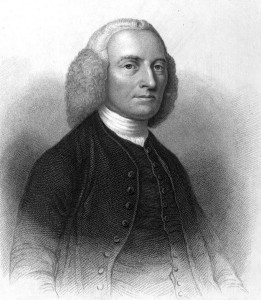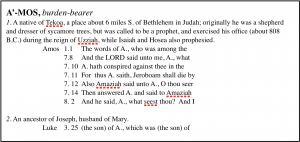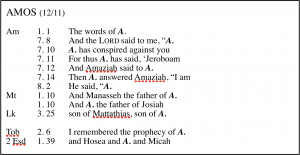We are at a point at which different students and teachers would approach the same essay in different ways. You could, for example, keep working through the text of Amos making full use of any cross references supplied in your Bible. Or you could make use of some of the many tools available to you. A tool is there to help you. If it does not make your work easier you may be using the wrong tool or the right tool in the wrong way. Remember that tools are there to serve you but, if used in the wrong way, they can be a hindrance. They might make you lazy or stop you thinking for yourself. But life is too short to do everything by hand so, with this note of caution, we are going to get some help.
Our first tool is going to be a concordance. We will start by looking at some of the book versions as, basically, an on-line concordance works in the same way. The earliest (pre-printing) concordances were word lists with key words listed, in alphabetical order, accompanied by a list of references in which the actual words occur. Here is our first warning: a concordance lists the actual words but not synonyms. Take this (made up) example.
King David was angry with the prophet who had told him that unless he repented he would no longer be king and his kingdom would be taken away.
How many times is David referred to in that sentence? The concordance will tell us that “David” is used once. But what about the other references to David that do not use his name?
King David was angry with the prophet who had told him that unless he repented he would no longer be king and his kingdom would be taken away.
“Him”, “he” (twice), “king” and “his” are all references to David. In this example we would still find David as our concordance would send us to the second word in the sentence, “David” but if the pronouns (him, he, his) and title (king) were spread out over several verses we would pick them up only if we read on from the first “David.”
So here is another top tip: read around the reference (backwards and forwards) when using a concordance and also look for obvious synonyms. Staying with David as our example, you could also look for “Son of Jesse”, “the king” “father of Solomon” and quite a few more.
The most famous concordance was prepared by Alexander Cruden. It was popular because it was the first to be available to the rapidly expanding educated middle-class and because Cruden promoted it well, but it is flawed. Cruden published it in 1737 so naturally it was based on the King James’ Version. However, Cruden’s chief problem is that he does not list every word in the Bible. Certainly this saves a great deal of space by not including every conjunction (e.g., “and”) and article (e.g., “an”) but we can never be certain if Cruden has listed every verse in which the word we are looking for occurs. Hopefully Cruden will give the important ones but if you are looking for all the references he may let you down.
Ever since Cruden, editors of concordances have wrestled with the question of how much to leave out. James Strong and Robert Young both tried to improve on Cruden by including more words. Strong’s Concordance is “exhaustive” and includes every single word in the King James’ Version. Young’s Concordance is “analytical” and lists every noun and verb and, to all intents and purposes, every word you are likely to look for.
Another example: if you were using a concordance to find the exact location of a verse you would focus on the key words. Say you could not remember where the Bible says “The Lord is my shepherd, I shall not want” you would not track it down by turning to “is”, “my”, “I” or “shall” as there are far too many references to work through. Even “ Lord” fills several pages, so the best word to look for would be “shepherd”. To save you looking, there are 62 verses in the Old Testament which contain a “shepherd” and sixteen in the New and the one we are looking for is, of course, Psalm 23.
If you have access to a Bible concordance (and most British libraries would have one in the reference section) now would be a good time to  go on an Amos hunt. If you cannot get to a paper concordance but have Internet access then visit www.biblegateway.com click on “Keyword Search” and follow the instructions. If you cannot get hold of any concordance at all, please read on.
go on an Amos hunt. If you cannot get to a paper concordance but have Internet access then visit www.biblegateway.com click on “Keyword Search” and follow the instructions. If you cannot get hold of any concordance at all, please read on.
Young’s Analytical Concordance has this:
Note that Young starts with a definition of the Hebrew word Amos. He says it means “burden-bearer” but you may wish to get a second opinion on that. Then Young summarises what the Bible tells us about Amos: he is “a native of Tekoa” and so on. Again, this is Young’s explanation of what the Bible says so we need to check that he is correct. And then he gives us the primary data we need: a list of all the occurrences of the name “Amos” – all seven of them and all seven within the Book of Amos. Plus that one other Amos in the genealogy in Luke who does not appear to be “our” Amos. Thank you Dr. Young.
This is probably sufficient for our needs but while we are looking at concordances let us have a quick glance at a more modern one. The example I have selected is NRSV Exhaustive Concordance edited by Bruce M. Metzger and published by Thomas Nelson in 1991. It says:
Note that the NRSV Concordance has none of the comments / explanations offered by Young. It also has a helpful pair of numbers at the top: 12/11. This means there are twelve uses of the word Amos to be found in eleven verses. We could find this information in Young’s concordance but we would have to count it for ourselves. Note the references to Amos in the Book of Amos are pretty much the same in both KJV and NRSV, as we would expect. And note also the differences in the New Testament where the KJV is confined to just Luke 3: 25 but the NRSV has two references in Matthew as well. But which Amos is in view? We need to note this and check later. And finally for the NRSV there are the two references from the Apocrypha in Tobit 2: 6 and 2 Esdras 1: 39. From the brief context supplied these two Apocryphal references seem to have “our” Amos in view and so should be noted now and read in full later.
I think it is fair to say that by using two concordances based on two different translations we should be confident that we have caught all references to Amos. A final check should prove this. The Eyre and Spottiswoode Study Bible mentioned above has brief, 191 page “Concordance to the Holy Bible (Revised Standard Version)” edited by Eugene A. Nida (1962). This has just four references to Amos, all within the Book of Amos and so adds nothing to our list. It looks like we have all the references we are going to find: seven direct mentions in seven verses, all within the Book of Amos, three mentions in the New Testament genealogies (if this is the same Amos) and then the two in the Apocrypha.
< Step Five (and a half): Taking notes Step Six: More reading >



